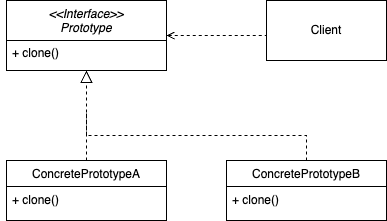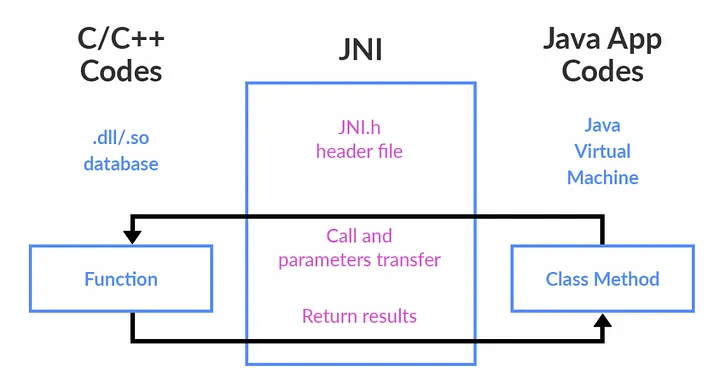[디자인패턴] 프로토타입 패턴(Prototype Pattern)
태그: Design Pattern, Java, Refactoring
카테고리: Design Pattern
프로토타입 패턴
- 프로토타입 패턴에 대해 알아보고 사용 사례를 살펴봅니다.
정의
기존 인스턴스를 복제하여 새로운 인스턴스를 만드는 방법
- 복제 기능을 갖추고 있는 기존 인스턴스를 프로토타입으로 사용해 새 인스턴스를 만들 수 있다.
주요 구성 요소

객체를 복제할 때 생기는 문제점
객체를 복제하는 것은 생각처럼 간단한 일이 아닐 수 있다. 다음과 같은 몇가지 문제가 있는데 하나씩 살펴보자.
객체 외부에서 private 필드를 복사할 수 없다.
객체의 복제본을 생성하려면 객체의 클래스를 알아야 한다.
클래스 의존도가 높아진다.
인터페이스 기반 설계 문제
구체 클래스에 의존하지 않고 객체를 복제하기 어렵다.
위와 같은 문제를 회피하면서도 복제할 수 있는 방법에 대해 알아보자.
프로토타입 패턴 예제
우선 프로토타입 패턴의 구성요소대로 인터페이스를 만든다. 왜 인터페이스가 필요한지에 대해선 코드를 통해 알아 보겠다.
1
2
3
public interface Prototype {
Prototype clone();
}
그 후 인터페이스를 구현하는 클래스 내에서 clone() 메소드를 재정의한다.
GameCharacter
1
2
3
4
5
6
7
8
9
10
11
12
13
14
15
16
17
18
19
20
21
22
23
24
25
26
27
28
29
30
31
32
33
34
35
36
37
38
39
40
41
42
43
44
45
46
47
48
49
50
51
52
53
54
55
56
57
public class GameCharacter implements Prototype {
private String name;
private int level;
private String profession;
public GameCharacter(String name, int level, String profession) {
this.name = name;
this.level = level;
this.profession = profession;
}
public String getName() {
return name;
}
public void setName(String name) {
this.name = name;
}
public int getLevel() {
return level;
}
public void setLevel(int level) {
this.level = level;
}
public String getProfession() {
return profession;
}
public void setProfession(String profession) {
this.profession = profession;
}
// clone 재정의
@Override
public Prototype clone() {
return new GameCharacter(name, level, profession);
}
@Override
public String toString() {
return "GameCharacter [name=" + name + ", level=" + level + ", profession=" + profession + "]";
}
@Override
public boolean equals(Object o) {
if (this == o)
return true;
if (!(o instanceof GameCharacter))
return false;
GameCharacter that = (GameCharacter) o;
return level == that.level && Objects.equals(name, that.name) && Objects.equals(profession,
that.profession);
}
}
Client
1
2
3
4
5
6
7
8
9
10
11
12
13
14
15
16
17
18
19
20
21
22
23
24
25
26
27
28
29
30
31
32
33
34
35
36
37
38
39
40
41
42
43
44
45
public class Client {
public static void main(String[] args) {
List<Prototype> characters = new ArrayList<>(); // 원본 저장용 리스트
List<Prototype> charactersCopy = new ArrayList<>(); // 복제 저장용 리스트
// 원본 객체 생성
GameCharacter originalCharacter = new GameCharacter("Archer", 10, "Archer");
characters.add(originalCharacter);
// 복제 객체 생성
GameCharacter clonedCharacter = (GameCharacter) originalCharacter.clone();
characters.add(clonedCharacter);
// 복제 객체의 속성 변경
clonedCharacter.setName("Mage");
clonedCharacter.setProfession("Mage");
// 출력
System.out.println("Original Character: " + originalCharacter);
System.out.println("Cloned Character: " + clonedCharacter);
System.out.println();
cloneAndCompare(characters, charactersCopy);
}
private static void cloneAndCompare(List<Prototype> characters, List<Prototype> charactersCopy) {
// 이 부분이 인터페이스를 사용한 이유다.
for (Prototype character : characters) {
charactersCopy.add(character.clone());
}
for (int i = 0; i < characters.size(); i++) {
if (characters.get(i) != charactersCopy.get(i)) {
System.out.println(i + ": 서로 다른 캐릭터 객체다. (yay!)");
if (characters.get(i).equals(charactersCopy.get(i))) {
System.out.println(i + ": 그리고 서로 같은 객체다.(yay!)");
} else {
System.out.println(i + ": 그러나 서로 다른 객체다. (booo!)");
}
} else {
System.out.println(i + ": 서로 같은 프로토타입 객체다. (booo!)");
}
}
}
}
위 코드에서 characters 배열에서 값을 꺼내 각각을 clone() 할때 구체적인 클래스를 몰라도 일관된 방식으로 코드를 작성 가능하다. clone() 내부에서 구체 클래스가 만들어져 복제된다.
1
2
3
for (Prototype character : characters) {
charactersCopy.add(character.clone());
}
출력결과
1
2
3
4
5
6
7
Original Character: GameCharacter [name=Archer, level=10, profession=Archer]
Cloned Character: GameCharacter [name=Mage, level=10, profession=Mage]
0: 서로 다른 캐릭터 객체다. (yay!)
0: 그리고 서로 같은 객체다.(yay!)
1: 서로 다른 캐릭터 객체다. (yay!)
1: 그리고 서로 같은 객체다.(yay!)
clone() 팩토리 메소드 안에서 새로운 객체를 리턴하고 있기 때문에 서로 다른 주소값을 가진 객체다. 그리고 객체 내부 필드값이 같은 경우 같은 객체로 보기위해 equals() 를 재정의 하였기 때문에 서로 같은 객체임이 보장된다.
java 에서 지원하는 Cloneable 인터페이스
java 에서는 clone() 을 위한 Java Native Interface 를 지원한다. 해당 메소드 구현 시 super.clone() 을 호출하게 되면 내부적으로 얕은 복사가 진행된다.
1
2
@HotSpotIntrinsicCandidate
protected native Object clone() throws CloneNotSupportedException;
해당 메소드는 Object 클래스에 있고, 복제 메소드가 필요한 클래스에서 재정의 하면 되는데, 그 클래스는 Cloneable 이라는 인터페이스를 구현하고 있어야 한다.
1
2
public interface Cloneable {
}
Cloneable 인터페이스는 아무런 메소드도 존재하지 않는데, 이를 마커 인터페이스(Marker Interface)라 한다. 마커 인터페이스가 구현된 클래스는 특정 속성임을 java 가 알 수 있도록 해준다.
Cloneable 인터페이스가 구현되어 있는 클래스는 clone() 메소드를 호출할 수 있다는 자격이라고 보면된다. 만약 마커 인터페이스가 없는 상태에서 clone() 을 호출하게 되면 CloneNotSupportedException이 발생한다.
직렬화 객체에 직렬화가 가능함을 알리기위해 붙이는 Serializable 인터페이스의 경우도 마커 인터페이스다.
JNI
Java Native Interface 는 java 구현되지 않은 일부 프로세스를 가능하게 만든다. 예를 들어 하드웨어 조작 명령이나 직접적인 OS API 명령
 출처 : https://medium.com/@sarafanshul/jni-101-introduction-to-java-native-interface-8a1256ca4d8e
출처 : https://medium.com/@sarafanshul/jni-101-introduction-to-java-native-interface-8a1256ca4d8e
얕은복사 / 깊은복사
객체의 복제와 항상 함께 등장하는 주제 중 하나가 shallow copy / deep copy 라고 생각한다. 간단히 정리하면
- shallow copy : 객체의 최상위 레벨만 복사. 하위 객체는 참조를 공유. 원본 객체나 복사된 객체의 변경이 서로에게 영향을 미칠 수 있다.
- deep copy : 객체 전체를 재귀적으로 복사. 하위 객체까지 모두 독립적인 복사본 생성. 서로 영향을 미치지 않는다.
장점과 단점
- 장점
- 복잡한 객체를 만드는 과정을 숨길 수 있다.
- 기존 객체를 복제하는 과정이 새 인스턴스를 만드는 것보다 비용면에서 효율적일 수도 있다.
- 추상적인 타입을 리턴할 수 있다.
- 단점
- 복제한 객체를 만드는 과정 자체가 복잡할 수 있다. (순환 참조가 있는 경우)
자바에서 찾아보는 프로토타입
ArrayList.clone()
ArrayList 를 복사할때 clone() 메소드를 사용하면 된다.
 ArrayList 는 Cloneable 인터페이스를 구현하고 있다.
ArrayList 는 Cloneable 인터페이스를 구현하고 있다.
그러나 이 방법은 잘 쓰이지 않는다. 왜냐하면 보통 ArrayList 를 받을때 아래처럼 인터페이스 타입으로 받기 때문이다.
1
List<Item> items = new ArrayList<>();
List 인터페이스에는 clone() 메소드가 존재하지 않는다.
프로토타입 패턴을 쓰지 않고 생성자로 복사
ArrayList 의 생성자 중에 컬렉션 타입을 받는 생성자가 있다. 인자로 전달하면 복제된다.
ArrayList
1
2
3
4
5
6
7
8
9
10
11
12
13
public ArrayList(Collection<? extends E> c) {
Object[] a = c.toArray();
if ((size = a.length) != 0) {
if (c.getClass() == ArrayList.class) {
elementData = a;
} else {
elementData = Arrays.copyOf(a, size, Object[].class);
}
} else {
// replace with empty array.
elementData = EMPTY_ELEMENTDATA;
}
}
Client
1
List<Item> clone = new ArrayList<>(items); // 파라미터로 컬렉션 타입을 전달하면 복제된다.
해당 메소드 중간에 Arrays.copyOf() 메소드를 통해 파라미터로 넘겨받은 컬렉션을 복사한다.
리플랙션 사용
리플랙션을 이용한 라이브러리를 사용하면 복잡한 코드를 직접 짜지 않아도 쉽게 복제가 가능하다. 첫번째 인자로 오는 타겟 객체를 두번째 인자의 타입으로 변환시켜준다.
리플랙션 관련해서는 해당 글에서 정리했다.
ModelMapper 라이브러리
1
2
ModelMapper modelMapper = new ModelMapper();
GithubIssueData githubIssueData = modelMapper.map(githubIssue, GithubIssueData.class);
ObjectMapper 라이브러리
1
Map<String, Object> response = om.readValue(response, Map.class);
ObjectMapper 는 팀 프로젝트에서 OAuth 인증 시 플랫폼 별 상이한 JSON 을 파싱하기 위해 사용했던 경험이 있다. (코드보기)
Gson 라이브러리
복제할 인스턴스를 GsonBuilder 의 toJson() 의 파라미터로 넘겨주면 새로운 JSON 형태로 반환해준다. 아래 코드는 프로젝트에서 사용했던 코드의 일부분이다. (전체 코드보기)
1
2
3
4
5
// Result.class
@Override
public String toString() {
return new GsonBuilder().serializeNulls().create().toJson(this);
}
Rest api 반환 객체에 toString 을 재정의하고 JSON 객체로 리턴하기 위해 GsonBuilder 를 사용했다. 클라이언트 쪽 코드는 아래와 같이 일반적인 toString 을 호출하듯이 하면 JSON 형태로 반환할 수 있다.
1
2
3
4
5
@PostMapping("add")
public String add(@RequestBody @Valid CodeRequestDto codeRequestDto) throws Exception {
codeService.add(codeRequestDto);
return new Result<>().setResultData(codeService.list(Paging.builder().build())).toString();
}
아래에서 살펴볼 직렬화 방식과 같다고 보면 된다.
객체를 복제하는 다양한 방법
복사 생성자
복사 생성자
클래스 내부에
복사 생성자를 정의하여, 해당 클래스의 인스턴스를 매개변수로 받아 필드 값을 복사한다.
직렬화
직렬화
객체를 직렬화한 후 역직렬화하는 방법. 이 방법은 기존 객체와의 참조가 끊어져 깊은 복사를 보장한다.
자바스크립트에서는
JSON.stringify()와JSON.parse()를 통해 가능하다.
팩토리 메소드
팩토리 메소드
클래스의 의존성을 줄일 수 있다.
정리
프로토타입 패턴은 다른 패턴들에 비해 간단하다. 미리 만들어 놓은 프로토타입 객체를 복제하여 새로운 객체를 생성하는 패턴이다. 객체 생성 시 매번 DB 를 조회해야 하는 등과 같이 생성 비용이 큰 경우 사용할 수 있을 것 같다.
그러나 형태는 간단하지만 현업에서 쓰려면 clone() 메소드를 어떻게 작성해야 할지 생각을 해야될 것 같다.
특히 java 에서 지원하는 Cloneable 의 기본적인 구현 방식(super.clone())은 얕은 복사임을 인지하고 있어야 하고, 만약 깊은 복사를 구현해야 하는 경우, 객체의 모든 하위 객체들도 올바르게 복제되어야 하므로 구현이 까다로울 수 있다.
또한 복제된 객체가 프로토타입 객체에 밀접하게 연관되어 있어, 만약 원본 객체의 내용이 변경되면 새로운 객체를 만들기 위해 프로토타입을 갱신해야 할 수도 있다.

댓글남기기